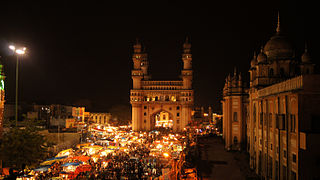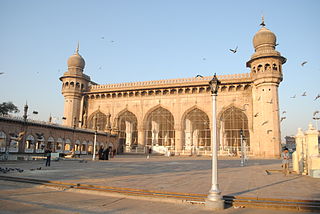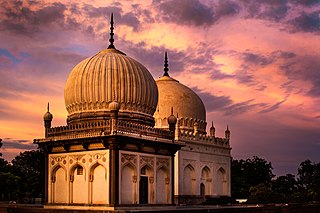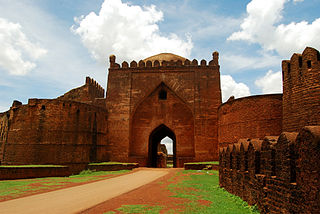
The Charminar is a monument located in Hyderabad, Telangana, India. Constructed in 1591, the landmark is a symbol of Hyderabad and officially incorporated in the emblem of Telangana. The Charminar's long history includes the existence of a mosque on its top floor for more than 425 years. While both historically and religiously significant, it is also known for its popular and busy local markets surrounding the structure, and has become one of the most frequented tourist attractions in Hyderabad. Charminar is also a site of numerous festival celebrations, such as Eid-ul-adha and Eid al-Fitr, as it is adjacent to the city's main mosque, the Makkah Masjid.

The Sultanate of Golconda was an early modern kingdom in southern India, ruled by the Persianate, Shia Islamic Qutb Shahi dynasty of Turkoman origin. After the collapse of the Bahmani Sultanate, the Qutb Shahi dynasty was established in 1512 by Quli Qutb Shah, as one of the five Deccan sultanates.

Sultan Muhammad Qutb Shah was the sixth ruler of the kingdom of Golconda in southern India under the Qutb Shahi dynasty.

Makkah Masjid or Mecca Masjid, is a congregational mosque in Hyderabad, India. It is the largest mosque in the city, and one of the largest in the country, with a capacity of 10,000 people. The mosque was built during the 17th century, and is a state-protected monument. It serves as the primary mosque for the Old City of Hyderabad, and is located close to the historic landmarks of Charminar, Chowmahalla Palace and Laad Bazaar.

Indo-Islamic architecture is the architecture of the Indian subcontinent produced by and for Islamic patrons and purposes. Despite an initial Arab presence in Sindh, the development of Indo-Islamic architecture began in earnest with the establishment of Delhi as the capital of the Ghurid dynasty in 1193. Succeeding the Ghurids was the Delhi Sultanate, a series of Central Asian dynasties that consolidated much of North, East, and Central India, and later by the Mughal Empire during the early 16th century. Both of these dynasties introduced Islamic architecture and art styles from West Asia into the Indian subcontinent.

Hayathnagar is a busy residential locality Hyderabad in Ranga Reddy district of the Indian state of Telangana, Pin Code 500070 & 501505. It is mandal headquarter of Hayathnagar mandal of Hayathnagar revenue division. Hayathnagar forms circle No 3 in Greater Hyderabad Municipal Corporation. There are four wards i.e Nagole (11) Mansoorabad (12), Hayathnagar (13) and B. N. Reddy Nagar (14) in this circle. It lies on National Highway 65.

The Qutub Shahi Tombs are located in the Ibrahim Bagh, close to the famous Golconda Fort in Hyderabad, India. They contain the tombs and mosques built by the various kings of the Qutub Shahi dynasty. The galleries of the smaller tombs are of a single storey while the larger ones are two-storied. In the centre of each tomb is a sarcophagus which overlies the actual burial vault in a crypt below. The domes were originally overlaid with blue and green tiles, of which only a few pieces now remain.

Abdullapur and Abdullapurmet together constitute a village in Ranga Reddy district in Telangana, India. Abdullapur is a village whereas Abdullapurmet is Mandal. It is 5 kilometers from the Outer Ring Road, Hyderabad. The world famous Ramoji Film City is in Abdullapurmet. Abdullapurmet is a developing residential locality on the outskirts of Hyderabad. It is located alongside Hyderabad-Suryapet Highway (NH-65). It has a population of about 5511. The male and female populations are 2822 and 2689 respectively. The size of the area is about 3.98 square kilometers.

Toli Masjid, also known as Damri Masjid, is a mosque in Hyderabad, in the Indian state of Telangana. It was constructed during the Qutb Shahi period and completed in 1671.

Persian Inscriptions on Indian Monuments is a book written in Persian by Dr Ali Asghar Hekmat E Shirazi and published in 1956 and 1958 and 2013. New edition contains the Persian texts of more than 200 epigraphical inscriptions found on historical monuments in India, many of which are currently listed as national heritage sites or registered as UNESCO world heritage, published in Persian; an English edition is also being printed.
The Telangana State Tourism Development Corporation is a state government agency which promotes tourism in Telangana, a state in the Southern region of India. The retired Director General of Police Pervaram Ramulu is the appointed First chairman of Telangana State Tourism. Tourist attractions in Telangana include historical places, monuments, forts, waterfalls, forests and temples.

Deccani architecture, particularly the architecture of the Bahmani and Deccan Sultanates, is the architecture of the Deccan Plateau, and is a regional variant of Indo-Islamic architecture. It was influenced by the styles of the Delhi Sultanate and later Mughal architecture, but sometimes also influenced from Persia and Central Asia. Hindu temple architecture in the same areas had very different styles.

The Musheerabad Masjid or Masjid e Kalan, is a mosque located in the Musheerabad locality of Hyderabad, India. The original portion was constructed in 1560 AD by Ibrahim Quli Qutb Shah, the fourth Sultan of the Qutb Shahi dynasty and is identical to the Hayat Bakshi Mosque located in Hayathnagar area of Hyderabad.
The localities and neighborhoods of Hyderabad have unique oral histories, dating to the time of the Qutb Shahi dynasty, over 400 years ago, and are named after various people and things. Some are named after a major building or structure in the locality, others named for individuals. The names are mostly in Telugu and Urdu, the major languages of the city. This is a list of localities, neighborhoods and streets of Hyderabad and their etymology.

Kulsum Begum Masjid is a mosque in the Karwan locality of Hyderabad, India. It was built in the 17th century by Kulsum Begum, daughter of Sultan Muhammad Qutb Shah.

A distinct Indo-Islamic architecture style with local contribution is reflected in the historical buildings of Hyderabad, making it the first and "Best Heritage City of India" as of March 2012. The city houses many famous historical sites constructed during Qutb Shahi and Asaf Jahi period, including various mosques and palaces.
Qutb Shahi architecture is the distinct style of Indo-Islamic architecture developed during the reign of the Qutb Shahi dynasty, also known as the Golconda Sultanate.
Jama Masjid is a 505 year old Mosque in Golconda, Hyderabad, India. It was constructed in 1518 by the first Qutb Shahi ruler Sultan Quli Qutb Shah - while he was governor of the Bahmani Sultanate in current Telangana.
Hayat Bakshi Begum was the royal consort of Sultan Muhammad Qutb Shah, the sixth ruler of the Qutb Shai Dynasty in south India and daughter of Muhammad Quli Qutb Shah, fifth Sultan of the dynasty. When her son Abdullah Qutb Shah was made sultan at the age of fourteen in 1626, she acted as regent for the first few years of his reign, and continued to wield considerable influence in the state until her death.














